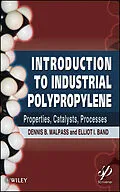This introductory text is an important resource for new
engineers, chemists, students, and chemical industry personnel to
understand the technical aspects of polypropylene which is the 2nd
largest synthetics polymer in manufactured output.
The book considers the following topics:
* What are the principal types of polypropylene and how do they
differ?
* What catalysts are used to produce polypropylene and how do
they function?
* What is the role of cocatalysts and how have they evolved over
the years?
* How are industrial polypropylene catalysts tested and the
resultant polymer evaluated?
* What processes are used in the manufacture of
polypropylene?
* What are the biopolymer alternatives to polypropylene?
* What companies are the major industrial manufacturers of
polypropylene?
* What is the environmental fate of polypropylene?
Autorentext
Dennis B. Malpass received his PhD in organometallic
chemistry from The University of Tennessee in 1970 and began his
career with Texas Alkyls, Inc. (now AkzoNobel). His industrial
career spanned thirty-three years working on synthesis,
characterization, and applications of metal alkyls, especially
aluminum alkyls in Ziegler-Natta polymerization of olefins. He has
more than eighty patents and publications and now consults in the
polyolefins industry. He also teaches organic chemistry and is an
instructor for continuing education courses for SPE and ACS. In
2010 he authored Introduction to Industrial
Polyethylene.
Elliot I. Band received his PhD in inorganic chemistry
from Cornell University in 1980. He has been in research and
development with AkzoNobel and its predecessor companies for over
thirty years. His tenure includes twenty years in Ziegler-Natta
catalyst synthesis, manufacture, quality control, and technical
support to polypropylene manufacturers in North and South America.
He presently manages a group of chemists and engineers that
develops new cationic, anionic, and nonionic surfactants for
AkzoNobel. Elliot has thirty publications and more than twenty
patents.
Zusammenfassung
This introductory text is an important resource for new engineers, chemists, students, and chemical industry personnel to understand the technical aspects of polypropylene which is the 2nd largest synthetics polymer in manufactured output.
The book considers the following topics:
- What are the principal types of polypropylene and how do they differ?
- What catalysts are used to produce polypropylene and how do they function?
- What is the role of cocatalysts and how have they evolved over the years?
- How are industrial polypropylene catalysts tested and the resultant polymer evaluated?
- What processes are used in the manufacture of polypropylene?
- What are the biopolymer alternatives to polypropylene?
- What companies are the major industrial manufacturers of polypropylene?
- What is the environmental fate of polypropylene?
Inhalt
List of tables xiii
List of figures xv
Preface ix
1 Introduction to Polymers of Propylene 1
1.1 Origins of Crystalline Polypropylene 1
1.2 Basic Description of Polypropylene 4
1.3 Types and Nomenclature of Polypropylene 9
1.4 Molecular Weight of Polypropylene 12
1.5 Transition Metal Catalysts for Propylene Polymerization 15
1.6 Questions 17
References 18
2 Polymer Characterization 19
2.1 Introduction 19
2.2 Polymer Tacticity 24
2.3 Molecular Weight and Molecular Weight Distribution 36
2.4 Polymer Bulk Density 48
2.5 Particle Size Distribution and Morphology 50
2.6 Questions 54
References 55
3 Ziegler-Natta Catalysts 59
3.1 A Brief History of Ziegler-Natta Catalysts 59
3.2 Definitions and Nomenclature 61
3.3 Characteristics of Ziegler-Natta Catalysts 63
3.4 Early Commercial Ziegler-Natta Catalysts 65
3.5 Supported Ziegler-Natta Catalysts 67
3.6 Prepolymerized Ziegler-Natta Catalysts 68
3.7 Mechanism of Ziegler-Natta Polymerization 69
3.8 Questions and Exercises 73
References 73
4 Propylene Polymerization Catalysts 75
4.1 Introduction 75
4.2 Zero Generation Ziegler-Natta Catalysts 77
4.3 First Generation ZN Catalysts 79
4.4 Second Generation ZN Catalysts 82
4.5 Third Generation ZN Catalysts 84
4.6 Fourth Generation ZN Catalysts 86
4.7 Fifth Generation ZN Catalysts 89
4.8 ZN Catalysts for Atactic Polypropylene 92
4.9 Metallocenes and Other Single Site Catalysts 93
4.10 Cocatalysts for ZN Catalysts 94
4.11 Kinetics and ZN Catalyst Productivity 99
4.12 Concluding Remarks 102
4.13 Questions 102
References 105
5 Aluminum Alkyls in Ziegler-Natta Catalysts 111
5.1 Organometallic Compounds 111
5.2. Characteristics of Aluminum Alkyls 113
5.3 Production of Aluminum Alkyls 122
5.4 Reducing Agent for the Transition Metal 126
5.5 Alkylating Agent for Creation of Active Centers 127
5.6 Scavenger of Catalyst Poisons 128
5.7 Chain Transfer Agent 129
5.8 Questions 129
References 130
6 Single Site Catalysts and Cocatalysts 133
6.1 Introduction 133
6.2 The Structures of Metallocenes and SSCs 134
6.3 Non-Metallocene Polymerization Catalysts 138
6.4 Cocatalysts for SSCs 139
6.5 Supports for SSCs 143
6.6 Characteristics of mPP 145
6.7 Selected Applications of mPP Resins 148
6.8 Metallocene Synthesis 150
6.9 Syndiotactic Polypropylene 152
6.10 Commercial Reality and Concluding Remarks 154
6.11 Questions 155
References 156
7 Catalyst Manufacture 163
7.1 Introduction 163
7.2 Development of the Manufacturing Process 163
7.3 Chemistry of Catalyst Manufacture 164
7.4 Raw Materials Storage and Handling 166
7.5 Catalyst Preparation 167
7.6 Catalyst Drying 169
7.7 Catalyst Packaging 169
7.8 Recovery and Recycle of Spent Solvents 170
7.9 Prepolymerization at the Catalyst Manufacturing Plant 172
7.10 Plant Size 172
7.11 Site Safety 172
7.12 Quality Control and Specifications 174
7.13 Diagram of a Hypothetical Plant 174
7.14 Custom Manufacture 176
7.15 Brief Consideration of Metallocene Catalyst Manufacture 178
7.16 Concluding Remarks 179
7.17 Questions 179
References 180
8 An Overview of Industrial Polypropylene Processes 183
8.1 Introduction 183
8.2 Slurry (Suspension) Processes 188
8.3 Bulk ("Liquid Pool") Process 189
8....
